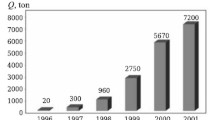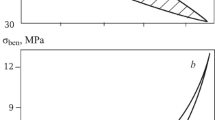The main aspects of obtaining an artificial ceramic binder (ACB) based on the original (quarry) and heat-treated diatomite are considered. The process of obtaining ACB is studied, and the main rheological properties and physicomechanical characteristics of specimens are analyzed. It is established that ACB based upon quarry diatomite exhibits thixotropic rheological behavior, and ACB based upon preheat-treated diatomite pertains to a thixotropic-dilatant type. Use of this technology for preparing a binder makes it possible to reduce molding moisture content in manufacture of various diatomite products and to improve their quality while reducing production costs compared with similar objects prepared by traditional technology.



Similar content being viewed by others
References
Yu. I. Goncharov, N. A. Peretokina, A. M. Tkachenko, and V. A. Fateev, “Ceramics based upon opaline rock – diatomite,” Stroit. Materialy, No. 9, 72 – 73 (2006).
V. A. Doroganov, E. A. Doroganov, E. I. Evtushenko, et al., “Refractory materials based upon artificial ceramic binder suspensions of silicon carbide composition,” Vestn. BGTU im. V. G. Shukova, No. 4, 156 – 160 (2013).
V. A. Doroganov, E. A. Doroganov, N. A. Peretokina, et al., “Corundum and zirconia composites based on artificial ceramic binders,” Refract. Ind. Ceram., 57(1), 92 – 97 (2016).
E. I. Evtushenko, N. A. Peretokina, L. A. Suleimanova, et al., “Heat insulation materials based upon artificial ceramic binders of different composition,” Vestn. BGTU im. V. G. Shukova, No. 6, 149 – 151 (2013).
V. A. Doroganov, E. A. Doroganov, N. S. Bel’maz, et al., “Development and study of composite refractory materials based on modified dispersed,” Refract. Ind. Ceram., 50(6), 431 – 437 (2009).
A. S. Zuev, E. I. Evtushenko, and V. A. Doroganov, “The use of artificial ceramic binders based on thermally activated high-alumina raw materials in a semi-dry pressing technology,” Refract. Ind. Ceram., 53(2), 97 – 100 (2012).
S. V. Zaitsev, V. A. Doroganov, E. A. Doroganov, and E. I. Evtushenko, “Study of artificial ceramic binders of mullite-silicon carbide composition and composites based on them,” Refract. Ind. Ceram., 58(1), 109 – 112 (2017).
E. I. Suzdal’tsev, T. V. Zaichuk, Yu. S. Ustinova, and S. N. Vandrai, “Preparation of highly concentrated binder suspensions based on magnesium aluminum silicate glass,” Refract. Ind. Ceram., 56(6), 601 – 604 (2016).
Yu. E. Pivinskii, Theoretical Aspects of Ceramic and Refractory Technology, Coll. work Vol. 1 [in Russian] Stroizdat, St. Petersburg (2003).
Yu. E. Pivinskii, Ceramic and Refractory Materials, Coll. work Vol. 2 [in Russian], Stroizdat, St. Petersburg (2003).
Yu. E. Pivinskii and A. G. Romashin, Quartz Ceramic [in Russian], Metallurgiya, Moscow (1974).
Yu. E. Pivinskii and M. A. Trubitsyn, “Highly concentrated ceramic binder suspensions. Dispersion medium, stabilization, and binding properties,” Refractories, 28(11/12), 635 – 642 (1987).
V. A. Doroganov and E. I. Evtushenko, Refractory Ceramic Concretes: Monograph [in Russian], LAB LAMBERT Academic Publishing GmbH & Co. KG, Saarbrücken (2011).
Yu. E. Pivinskii, “Highly concentrated ceramic binder suspensions. stabilization, rheological properties, and the principle of rheotechnological correspondence,” Refractories, 29(5/6), 335 – 342 (1988).
Yu. E. Pivinskii, Rheology of Dispersed Systems, HCBS and Ceramic Concretes. Elements of Nanotechnology in Silicate Material Science. Coll. work, Vol. 3 [in Russian], Politekhnika, St. Petersburg (2012).
Yu. E. Pivinskii, “Cement-free refractory concretes. Part 1. General information. HCBS and ceramic concretes,” Refract. Ind. Ceram., 60(5), 430 – 438 (2019).
Work was performed within the scope of a V. G. Shukov BGTU development program for 2021 – 2030 “Priority 2030”.
Author information
Authors and Affiliations
Corresponding author
Additional information
Translated from Novye Ogneupory, No. 5, pp. 108 – 112, May, 2023
Rights and permissions
Springer Nature or its licensor (e.g. a society or other partner) holds exclusive rights to this article under a publishing agreement with the author(s) or other rightsholder(s); author self-archiving of the accepted manuscript version of this article is solely governed by the terms of such publishing agreement and applicable law.
About this article
Cite this article
Peretokina, N.A., Doroganov, V.A., Doroganov, E.A. et al. Heat-Resistant Ceramic Concrete Based Upon Diatomite. 1. Synthesis and Study of Artificial Ceramic Binders Based Upon Diatomite. Refract Ind Ceram 64, 291–295 (2023). https://doi.org/10.1007/s11148-024-00840-6
Received:
Published:
Issue Date:
DOI: https://doi.org/10.1007/s11148-024-00840-6




